
109
HNUE JOURNAL OF SCIENCE
Educational Sciences 2024, Volume 69, Issue 5B, pp. 109-121
This paper is available online at http://hnuejs.edu.vn/es
DOI: 10.18173/2354-1075.2024-0139
ORGANIZING ACTIVITIES FOR PRIMARY STUDENTS
TO EFFECTIVELY LEARN MATHEMATICAL VOCABULARY
Nguyen Phuong Chi1 and Vu Thi Hoach2,*
1Faculty of Mathematics and Information Technology, Hanoi National University of Education,
Hanoi city Vietnam
2Faculty of Primary Education, Hai Duong University, Hai Duong city Vietnam
*Corresponding author: Vu Thi Hoach, e-mail: hoachdhhdth@gmail.com
Received June 20, 2024. Revised October 20, 2024. Accepted December 28, 2024.
Abstract. Using mathematical language is of great significance to students in the process of
learning mathematics. Improving students' mathematical language skills contributes to
improving their mathematical learning outcomes. This process must be done continuously
throughout the learning process. Mathematical vocabulary is an important part of
mathematical language, the mastery of which fosters students to enhance their ability to use
mathematical language accurately and effectively, thereby forming their mathematical logic
senses. This article presents, based on basic mathematical language activities, a number of
teaching organizing measures in which teachers support students to comprehend and use
vocabulary effectively in learning and in practice.
Keywords: mathematical vocabulary, mathematical language, teaching mathematics in
primary school.
1. Introduction
The foundation of mathematical language is mathematical vocabulary. Vocabulary is an
integral factor in learning and mastering mathematical concepts. Developing sufficient
vocabulary is an important goal in teaching mathematics, especially for students with poor
language skills, who likely have inefficient problem-solving skills, an important skill in learning
mathematics. In school, students who lack a foundation of vocabulary knowledge would struggle
in the task of reading, writing, verbalizing mathematical concepts, and solving problems
necessary for learning mathematics. Understanding and using vocabulary correctly is crucial to
students' effective Mathematics learning. Therefore, organizing language activities to help
students learn effectively is essential in teaching mathematics in general and in primary schools
in particular.
Tran Ngoc Bich (2013) studied students’ vocabulary knowledge in the first grade in the
direction of developing effective reading skills concerning (1) Organizing student activities to
form mathematical language knowledge including syntax and semantics of mathematical
language; (2) Training students to use mathematical language in teaching concepts, rules,
properties and solving problems [1]”. Thai Huy Vinh (2016) focused on the development of
mathematical language skills for primary school students in grades 4 and 5, specifically, in order to:

Nguyen PC & Vu TH*
110
(1) Introduce and develop vocabulary knowledge for students; (2) Make students understand
semantics associated with the correct use of mathematical language syntax; (3) Train students’
skill to convert natural language to mathematical language and vice versa” [2].
It can be found that the mathematical language in primary school, especially mathematical
vocabulary, has been explored by multiple researchers. Yet, there is still a gap for a specific way
to help primary school students comprehend, memorize, and apply mathematical vocabulary
effectively in learning mathematics that calls for adequate research actions.
2. Content
2.1. Some features of mathematical vocabulary
Hoang Chung (1994) believes that: "Mathematical language only includes mathematical
symbols and terms" [3]. Not stopping there, mathematics educators in Vietnam continue to
research mathematical language and add "diagrams, drawings, charts, graphs, etc." as components
of mathematical language. The concept of mathematical language is expanded by researchers
such as Le Van Hong (2003), Tran Ngoc Bich (2013), Vu Thi Binh (2016): "Mathematical
language is the language of science, including a set of mathematical symbols, symbols (diagrams,
drawings, charts, graphs, etc.), mathematical terms (words, phrases) and a set of rules for
combining them to express, represent, notify, demonstrate and communicate objects and
mathematical relationships while speaking, writing or thinking." [1], [4], [5]. Pham Van Hoan
(1981) states that in teaching mathematics: “Spoken language is used in combination with visual
language in textbook films, in audio tapes, etc." [6], thus, images are the objects of mathematical
language, too.
When considering the relationship between mathematical vocabulary and mathematical
concepts, the two authors Eula Ewing Monroe & Robert Panchyshyn (1995) divide mathematical
vocabulary into 4 types: (1) Mathematical terms; (2) General vocabulary; (3) Symbols - signs; (4)
words with multiple meanings even in mathematics” [7].
Thus, mathematical vocabulary is a set of words, terms, signs, symbols (diagrams, drawings,
charts, etc.), and mathematical images used to describe, represent, and express mathematical
content.
Mathematical terms refer to words and phrases that represent concepts, mathematical objects,
and relationships in the field of mathematics, for example: even numbers, odd numbers, straight
lines, right angles, denominators, numerators, etc.
Mathematical symbols include digits and symbols (+, :, …). Digits are the most common
mathematical characters, representing numbers, and they are highly abstract. In addition, a
specific digit can be used to express many different meanings. For example, consider the digit 2
in the following numbers:
13.25 325 82 1
2
2
3 15m2
The digit 2 has different meanings (digit, power, denominator, numerator, unit of area) and
is highly abstract in each mathematical content it represents. In addition to the ability to provoke
complexity, the same meaning can be presented with different characters.
Mathematical symbols include diagrams, drawings, charts, graphs, etc. used to represent,
express, and demonstrate mathematical relationships and specific mathematical objects.
Mathematical diagrams are drawings that describe certain characteristics of objects, relationships,
and mathematical content. In elementary school mathematics content, there are line diagrams,
diagrams, models, drawings, charts, etc.

Organizing activities for primary students to effectively learn mathematical vocabulary
111
Mathematical imagery is a language expressed through images containing mathematical
content, relationships, and objects without using words or text characters. For example, below is
a mathematical image appearing in the Grade 1 Math textbook, “Canh Dieu” series [8].
Figure 1. Images in Grade 1 Math Textbook, “Canh Dieu” book series
The vocabulary system of a language is the basic component of that language. A vocabulary
system along with its meanings is indispensable for the proficient use of a certain language.
Mathematical vocabulary is essential in communicating mathematical ideas and concepts, the
mastery of which is vital to children's mathematics learning.
2.2. Mathematical language activities in teaching mathematics in schools
Nguyen Ba Kim (2007) affirms that: "Each teaching content is related to certain activities;
Language activities are one of the activities that appear in teaching Mathematics content in
schools. Language activities are conducted when asking students to state and explain a certain
definition or proposition, especially in their own words, or transform them from one form to
another” [9]. Accordingly, the author points out that concept teaching activities, it is necessary to
"pay attention to guiding and encouraging students to express definitions differently, in their own
words".
When researching mathematical representations, Vu Thi Binh (2016) proposes 3 forms of
mathematical language activities: “(1) Receiving mathematical language activities in terms of
vocabulary, syntax, and semantics, etc; (2) Activities to convert ideas into words; (3) Language
conversion activities from different forms of cognitive language, translating from natural
language to cognitive language and vice versa” [5]. Le Van Hong (1998), when considering
mathematical language in an expanded sense, along with the view that Mathematical discourse
(spoken or written text) is a multi-signal genre, presents 4 types of mathematical language
activities: “(1) Converting Mathematical content and ideas into a "physical shell", using signals
from mathematical language; (2) Identifying mathematical content from certain mathematical
languages; (3) Adjusting linguistic forms to keep the content and mathematical ideas intact;
(4) Transforming signals of mathematical language, especially the signal of mathematical
symbols, while still retaining parts of the content of mathematical ideas”.

Nguyen PC & Vu TH*
112
Based on the processes of teaching typical mathematics situations at the primary school level,
including the formation of mathematical concepts, mathematical rules, formulas, algorithms, and
mathematical problem solving, etc., we propose the following mathematical language activities:
(i) Acquiring mathematical language in terms of vocabulary, syntax, and mathematical
semantics accurately, logically, and systematically.
Mathematical vocabulary at the elementary level is the first mathematical language equipped for
students in the precise sense of mathematics. In addition, vocabulary is highly specialized,
including terms (words and phrases), symbols (drawings, diagrams, charts, etc.), and visual
language. The syntax of mathematical language is the rules for combining symbols and
mathematical terms into mathematical formulas, expressions, and propositions. The semantics of
mathematical language is understood as the meaning or content of symbols, terms, and
mathematical symbols. For example, the term “Four plus two equals six” when taught to first graders:
Example 1. When teaching the lesson “Addition within 6” (Math 1, “Canh Dieu”
Textbook Series) [8].
- Syntax: 4 + 2 = 6.
- Semantics: 4 plus 2 equals 6 or 4 plus 2 equals 6.
Attention to the process of forming and training students to understand and use mathematical
words, terms, and symbols in definitions, rules, properties, and formulas, and to express
mathematical propositions correctly and logically contributes to more effective mathematical
operations. When students receive mathematical language using this activity, it helps them learn
about the ideas of mathematical content that the mathematical language expresses through
vocabulary, semantics, and syntax accurately, logically, and systematically.
(ii) Activities of expressing and describing mathematical content based on a specific
mathematical language.
Each unit of knowledge in the textbook is initially presented through images, diagrams,
drawings, then mathematical symbols, and mathematical terms, so the activity of describing and
expressing mathematical content with images, diagrams, and drawings is critical to students’
process of learning mathematics. When stating mathematical rules and properties, the very first
step to support student’s understanding and application is to describe and express those rules and
properties using symbols or specific syntax at specific values.
For example: When 4th graders learn the rule for calculating the area of a parallelogram,
teachers can organize the following pedagogical activity to instruct students to describe the
mathematical content from a certain mathematical language.
Example 2. Fill in the blank with the appropriate symbols.

Organizing activities for primary students to effectively learn mathematical vocabulary
113
or
The task of expressing, explaining, and describing mathematical concepts and symbols
requires students to mobilize knowledge and use language in general and mathematical language
in particular in accordance with the context, ensuring the correct connection between types of
mathematical language. In this activity, students recall the symbols and terms indicating the
concept that needs to be expressed and described, determine the characteristics of the concept,
and then state and describe it correctly. Furthermore, students can link concepts together, consider
their similarities, and state the definition of the concept, describing this object through a similar
object (maybe partially similar) to them.
(iii) Language conversion from different forms of mathematical language, conversion from
mathematical language to natural language, and vice versa.
In each concept, rule, and mathematical property, natural language is always used in
combination with terms, and symbols. Each statement (spoken) has many corresponding
expressions in writing and vice versa. In this activity, mathematical language is the main means
combined with natural language to create knowledge exchanges in mathematics learning
activities. The activity of expressing and stating mathematical rules and properties in many
different ways not only helps students remember and understand the nature of mathematical
concepts, rules, and properties but also helps students practice using natural language more
effectively while improving their ability to learn mathematics.
Take the following activities as some examples.
Example 3. When teaching 5th-grade students, teachers can organize students to state the
rules for calculating the area of a triangle in the following ways:
Option 1: The area of a triangle is calculated with the base multiplied by the height (same
unit of measurement) and then divided by 2.
Option 2: If S is the area of the triangle; h is the height corresponding to the base a,
then S = 𝑎 ℎ
2.
Option 3. If
then
The area of triangle ABC is


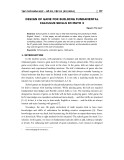

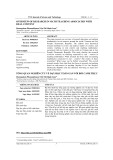

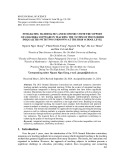
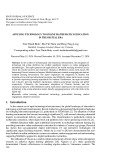

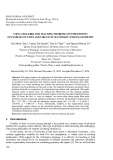
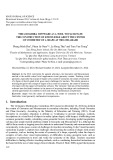
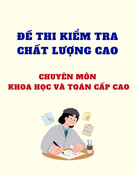
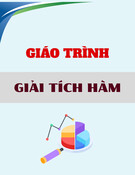
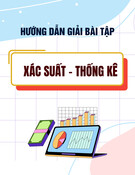
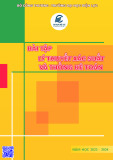






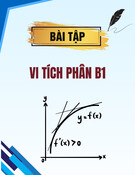
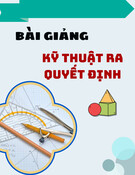
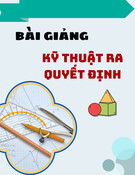
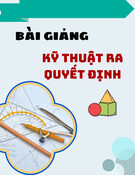
![Quyển ghi Xác suất và Thống kê [chuẩn nhất]](https://cdn.tailieu.vn/images/document/thumbnail/2025/20251030/anh26012006/135x160/68811762164229.jpg)
